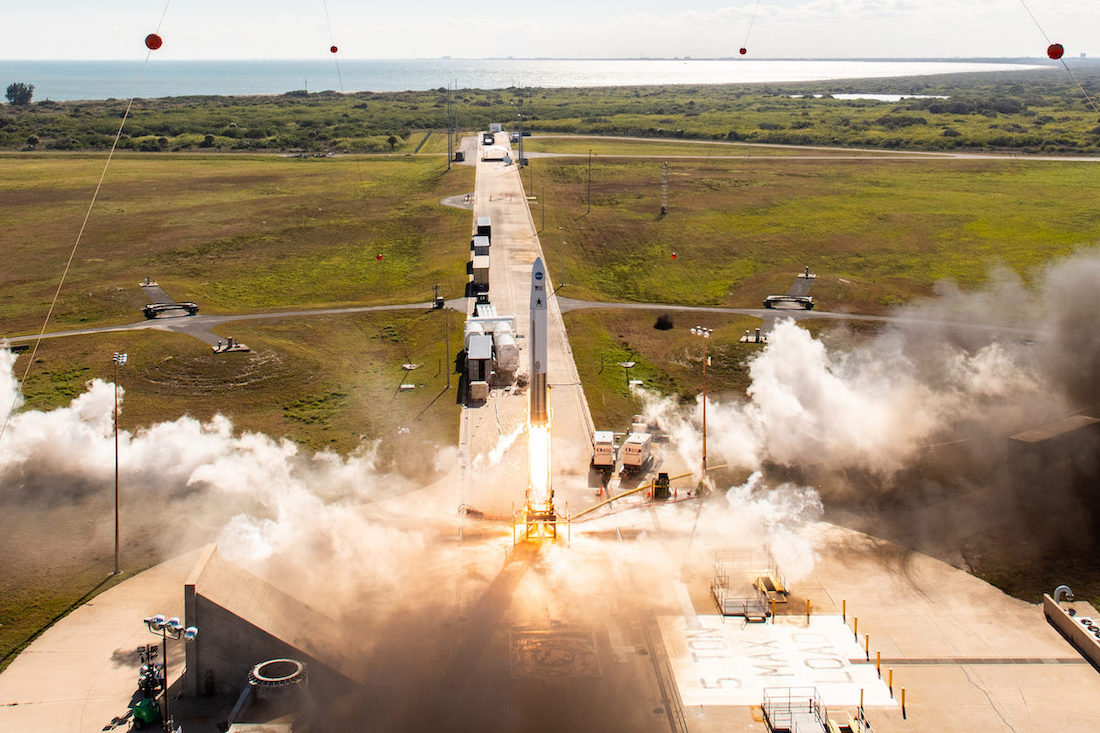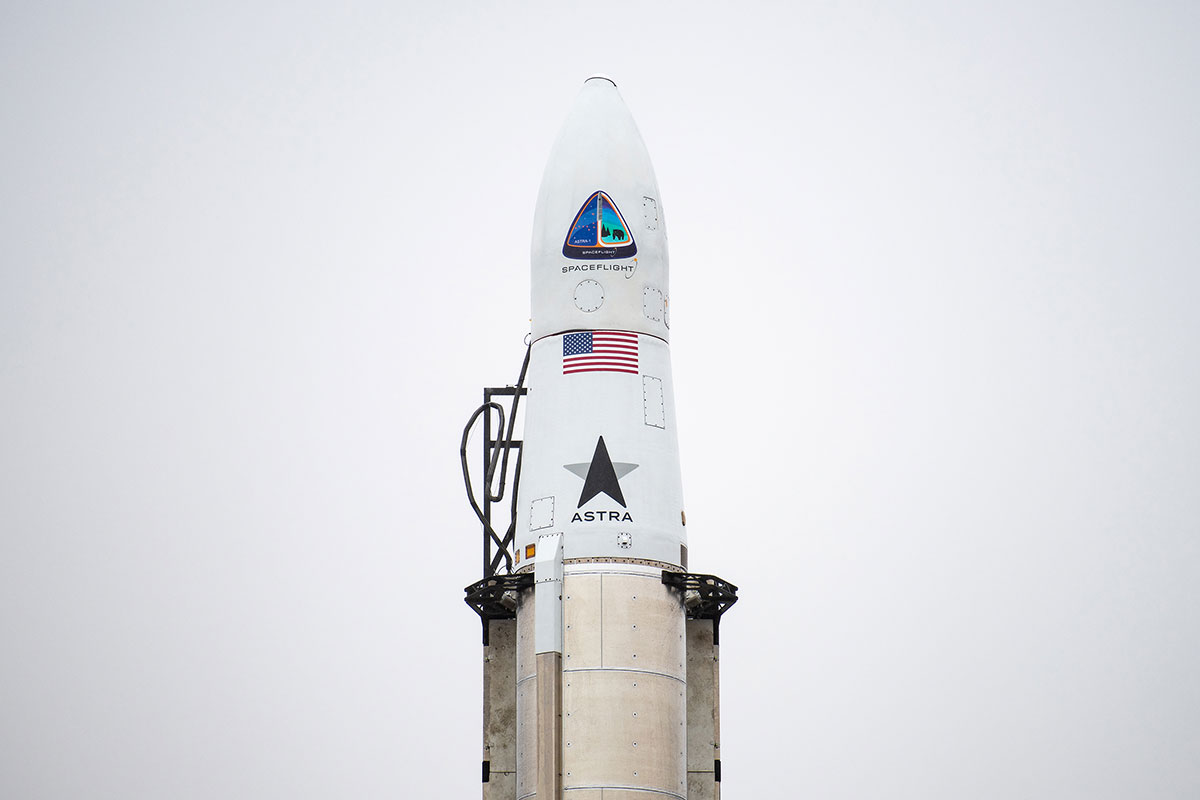Space News & Blog Articles
Astra’s return-to-flight launch ready for liftoff from Alaska
 Astra’s Rocket 3.3 lifts off from Cape Canaveral Space Force Station on Feb. 10. Credit: Brady Kenniston / Astra
Astra’s Rocket 3.3 lifts off from Cape Canaveral Space Force Station on Feb. 10. Credit: Brady Kenniston / Astra
Astra engineers identified two problems — an electrical design issue and a software glitch — that prevented a rocket from reaching orbit last month with a suite of NASA-sponsored CubeSats, clearing the way for a return-to-flight mission that could launch from Alaska as soon as Monday.
The company’s next mission is ready to lift off from Pacific Spaceport Complex on Kodiak Island, Alaska, with several small commercial payloads heading into a polar orbit.
Astra said the mission’s 27-minute launch window Monday opens at 12:22 p.m. EDT (1622 GMT; 8:22 a.m. AKDT). But the company cautioned that whether may be unfavorable for launch Monday, and could force a delay to Tuesday.
The launch was widely anticipated after airspace warning notices suggested a mission was scheduled to fly from Kodiak Island. But Astra did not officially confirm the launch plan until Monday morning, hours before the opening of the launch window, once it secured a launch license from the Federal Aviation Administration.
The mission’s customer is Spaceflight, a commercial launch broker and an arranger of rideshare launch services. Spaceflight said Monday it has three of its customers flying on Astra’s Rocket 3.3 launch vehicle, designated Launch Vehicle 0009, or LV0009. Two of the customers are Portland State Aerospace Society and NearSpace Launch, while the third was undisclosed.
Portland State Aerospace Society’s payload, named OreSat0, is a student-built nanosatellite developed at Portland State University in Oregon. NearSpace Launch’s payload, named S4 CROSSOVER, will remain attached to the Astra rocket’s second stage after entering orbit, testing communications instruments and gathering data on the space environment.
The launch of LV0009 marks Astra’s return to Kodiak Island, where the company’s first four orbital launch attempts. The first three test flights failed to reach orbit, but Astra successfully placed an inert payload into orbit for the U.S. Space Force in November.
That set the stage for Astra’s first mission with functional satellites on-board, which took off Feb. 10 from Cape Canaveral Space Force Station. But a problem during separation of the rocket’s payload shroud, followed by a software glitch on the upper stage, prevented the mission from completing its mission.
 Astra’s Rocket 3.3, designated LV0009, on its launch pad in Alaska. Credit: Astra / Brady Kenniston
Astra’s Rocket 3.3, designated LV0009, on its launch pad in Alaska. Credit: Astra / Brady Kenniston
Astra said March 6 that the launch from Florida last month failed to reach orbit after the rocket’s payload fairing did not fully open nearly three minutes after liftoff.
The two halves of the clamshell-like nose cone on Astra’s rocket were supposed to jettison after shutdown of the vehicle’s first stage engines, revealing the rocket’s second stage and satellite passengers to continue the climb into orbit.
Astra said an investigation led by company engineers, with oversight from the FAA, revealed that the payload fairing’s five separation mechanisms fired in the wrong order due to an electrical issue. That led to unexpected movement of the fairing structure, causing an electrical disconnection that prevented the final separation mechanism from receiving its command to open.
On-board video from the rocket showed the payload fairing start to open, but the two halves never fully separated to fall away from launch vehicle. That meant the upper stage lit its engine while still inside the fairing.
In a separate issue, Astra said engineers discovered a software problem that caused the upper stage to begin tumbling after firing away from the first stage and malfunctioning payload fairing.
Astra said the root cause of the payload fairing separation failure was an error in an engineering drawing, which caused technicians to improperly install wiring harnesses on the fairing separation system. Testing did not detect the problem before launch.
The software problem was rooted in a vulnerability to a “packet loss” failure mode, according to Astra. ” A missed series of signals resulted in a chain of events, resulting in the upper stage’s inability to recover from its tumble,” the company said in a statement.
Officials updated the engineering drawing and modified the payload separation system wiring harnesses on rockets already built in Astra’s factory, and introduced a new test to detect similar issues in the future. Engineers also upgraded software to overcome the problem that paralyzed the steering system ion the upper stage.
The LV0009 mission from Alaska is critical for Astra, which aims to eventually launch daily missions to carry small satellites into orbit for a range of customers, including the U.S. military, commercial companies, and NASA. So far, the company has successfully reached orbit in just one of five tries.
After the LV0009 mission, Astra plans to return to Cape Canaveral for a series of three launches for NASA in April and May, carrying NASA’s TROPICS CubeSats.
TROPICS, a weather research mission, stands for Time-Resolved Observations of Precipitation structure and storm Intensity with a Constellation of Smallsats. The mission will consist of six CubeSats flying in three orbital planes, with each Astra launch targeting a specific orbit in the constellation.
This email address is being protected from spambots. You need JavaScript enabled to view it. the author.
Follow Stephen Clark on Twitter: @StephenClark1.
When you subscribe to the SpaceZE News Feed, we will send you an e-mail when there are new updates on the site so you wouldn't miss them.

